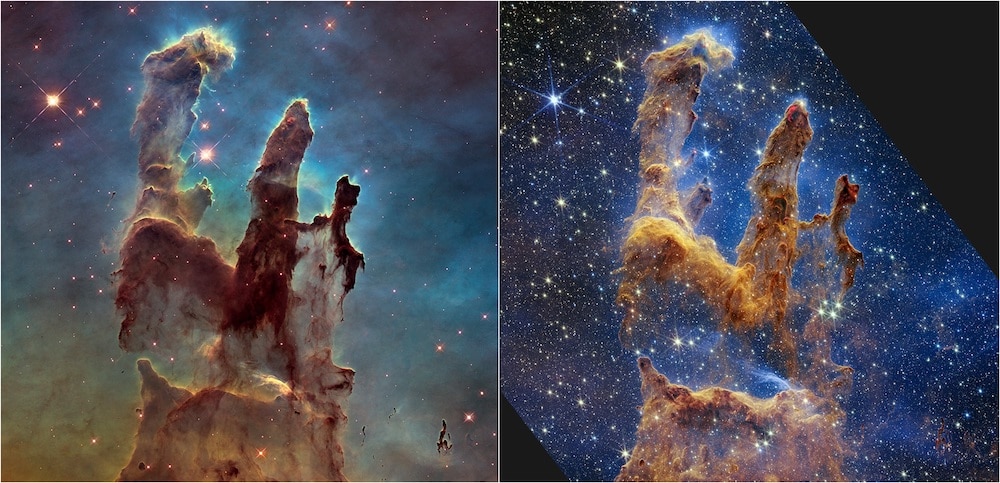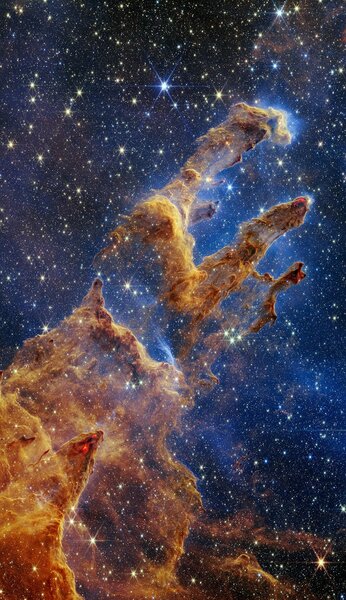Create a free profile to get unlimited access to exclusive videos, sweepstakes, and more!
JWST reveals stunning new view of the Pillars of Creation
The name was given both for the pillar-like shape, and also for the creative action happening inside.

The Space Race (now streaming on Peacock!) tells the story of the contest between the United States and the Soviet Union to land the first human beings on the Moon. It’s a thrilling real life tale of the human beings who turned humanity into a spacefaring species, and it’s a story which is still unfolding.
In the half-century since humanity first walked on the Moon, we’ve continued that legacy through the Space Shuttle program, several space stations, and the ongoing Artemis missions to return people to the Moon. While our ability to set boots on the surface of other worlds is limited, we’ve continued to explore the cosmos with our machines. A seemingly endless stream of probes, orbiters, landers, and rovers have gone everywhere from Mars to the edge of our solar system, providing detailed looks at the stuff which is relatively close to home. To see farther into space, however, you can’t beat a massive space-based telescope.
RELATED: Head-on cosmic collision: The incredible Cartwheel galaxy seen by JWST
For decades, the images from the Hubble Space Telescope were our window into a vast and beautiful universe. When we imagined the cosmos, we were really imagining it through Hubble’s eyes… or its mirrors and light sensors. It delivered countless incredible views of distant stars, galaxies, and nebulae, but few are more immediately recognizable than the Pillars of Creation. The original 1995 image revealed a portion of the Eagle Nebula some 7,000 lightyears away. The entire structure spans roughly eight lightyears, almost twice the distance from the Sun to the nearest star.
The name was given both for the pillar-like shape, and also for the creative action happening inside. The pillars are massive collections of interstellar gas and dust which are in the process of forming new stars. The original image shows what almost looks like a grasping hand reaching into the night, surrounded by a smattering of red-tinted stars. The image remains a triumph of astronomy, that we were able to peer so deep into the universe and capture something with such incredible detail. But there’s a new space telescope on the block and its revisiting some of Hubble’s old stomping grounds.
Recently, researchers pointed the James Webb Space Telescope (JWST) at the Pillars of Creation to take its own stab at imaging the structure, and the results are incredible. What before looked like a large but countable number of stars has been replaced with a field of stars so dense as to boggle the mind.
That’s the result of the way the JWST was designed to look at the sky. It’s collection of large mirrors gathers faint infrared light which is invisible or nearly invisible to the naked eye, then it translates that into something we can see. It’s the most sensitive space telescope we’ve ever built, and the difference is immediately apparent when looking at the images side by side (as shown up top).
When new stars begin forming inside the pillars, they’re shrouded from sight by the gas and dust around them. Then, as they evolve, they start blowing the gas and dust away, and suddenly we can see them. Infrared light, however, can get through the dust and that’s what the JWST is looking for. It’s almost like we’ve been looking at the sky through a thin piece of cloth and now, slowly, the blindfold is being removed. The result is an image awash in stars, all at various stages of their life cycles, thousands of lightyears away.
As new images continue to be captured and released, it’s clear that the JWST is going to change the way we see and imagine the universe, but it’s also contributing to science and a greater understanding of our universe. With the improved data from the Pillars of Creations, scientists can refine their models of star formation, but that’s almost gravy. The JWST cost something like 10 billion dollars to build and launch, and these images are worth every single cent.



























